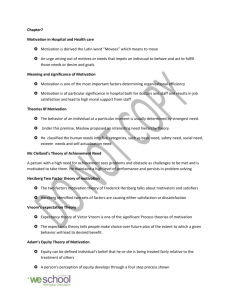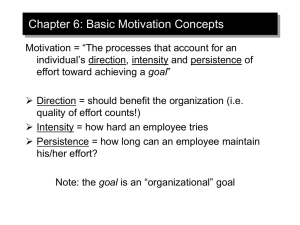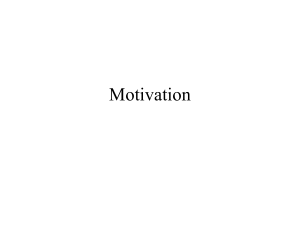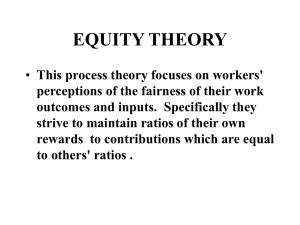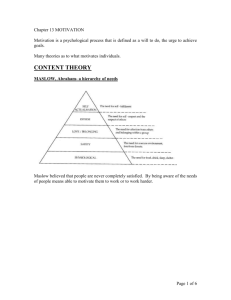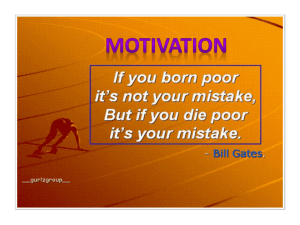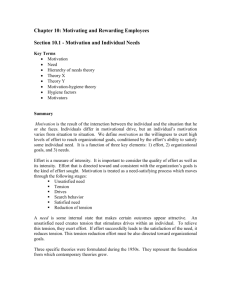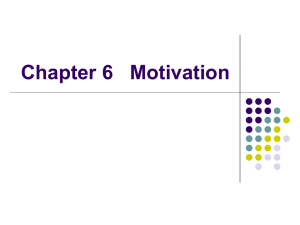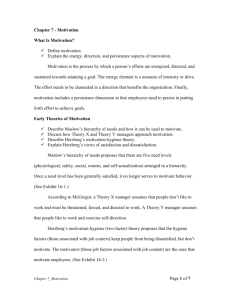chapter7
advertisement
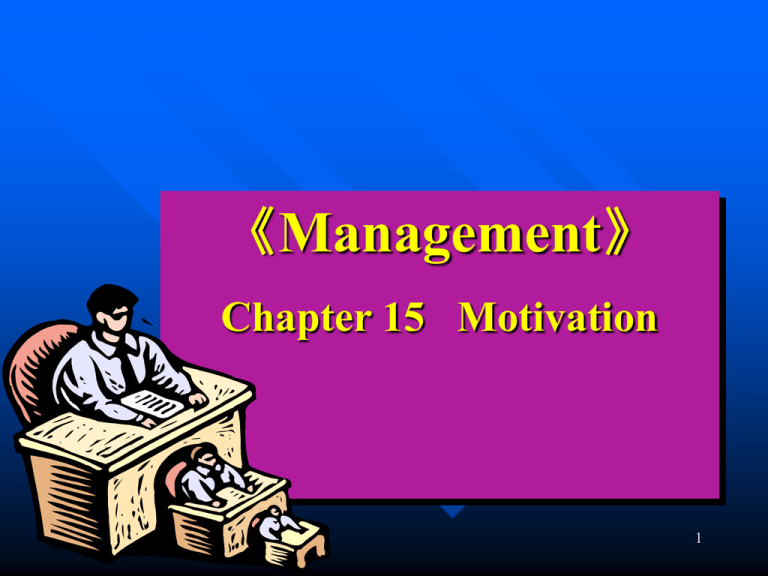
《Management》 Chapter 15 Motivation 1 LEARNI NG OUTLI NE Follow this Learning Outline as you read and study this chapter. – – – – – – Define motivation. Explain motivation as a need-satisfying process. Describe the five levels in Maslow’s hierarchy Describe Herzberg’s motivation-hygiene theory. Explain Adams equity theory Explain Skinner’s reinforcement theory 2 主要内容: 一、What Is Motivation? 二、Early Theories of Motivation 三、 Modern Theories of Motivation 四、From Theory to Practice 3 一、 (激励概述) What Is Motivation? Motivation The processes that account for an individual’s willingness to exert high levels of effort to reach organizational goals, conditioned by the effort’s ability to satisfy some individual need. 激励(motivation):在管理工作中,可把激励定义为 调动人们积极性的过程,即指人在外在力量的作用下, 通过满足个体的某种需要,从而使个体产生一种内在的 动力,去追求目标的心里活动的过程。 4 Motivation Process Unsatisfied needs nervous Drives Looking for action Needs satisfied Nervous Released 5 二、早期激励理论 (Early Motivation Theory) Maslow’s Hierarchy of Needs MacGregor’s Theories X and Y Herzberg’s Motivation-Hygiene Theory 6 Maslow’s Hierarchy of Needs Theory (马斯洛需求层 次理论) » Needs were categorized as five levels of lower- to higher-order needs. » Individuals must satisfy lower-order needs before they can satisfy higher order needs. » Satisfied needs will no longer motivate. – Motivating a person depends on knowing at what level that person is on the hierarchy. » Hierarchy of needs » Lower-order (external): physiological, safety » Higher-order (internal): social, esteem, self-actualization 7 Maslow’s Hierarchy of needs 自我 实现的需要 (Self-Actualization) 自尊的需要 (Esteem) 社交需要 (Social) 安全需要 (Safety) 生理需要 (Physiological) 8 McGregor’s Theory X and Theory Y Theory X – Assumes that workers have little ambition, dislike work, avoid responsibility, and require close supervision. Theory Y – Assumes that workers can exercise selfdirection, desire responsibility, and like to work. – Motivation is maximized by participative decision making, interesting jobs, and good group relations. 9 Herzberg’s Motivation-Hygiene Theory » Job satisfaction and job dissatisfaction are created by different factors. » Hygiene factors: extrinsic (environmental) factors that create job dissatisfaction. » Motivators: intrinsic (psychological) factors that create job satisfaction. » Attempted to explain why job satisfaction does not result in increased performance. » The opposite of satisfaction is not dissatisfaction, but rather no satisfaction. » The opposite of dissatisfaction is not satisfaction, but rather no dissatisfaction. 10 三、(现代激励理论)Contemporary Theories of Motivation Three-Needs Theory Expectancy Theory Equity Theory Reinforcement Theory 11 Expectancy Theory(期望理论) – States that an individual tends to act in a certain way based on the expectation that the act will be followed by a given outcome and on the attractiveness of that outcome to the individual. » Key to the theory is understanding and managing employee goals and the linkages among and between effort, performance and rewards. » Effort: employee abilities and training/development » Performance: valid appraisal systems » Rewards (goals): understanding employee needs 12 Expectancy Relationships » Expectancy (effort-performance linkage) – The perceived probability that an individual’s effort will result in a certain level of performance. » Instrumentality (performance-reward linkage) – The perception that a particular level of performance will result in the attaining a desired outcome (reward). » Valence (reward-needs linkage) » The attractiveness/importance of the performance reward (outcome) to the individual. 13 M=V x E Motives= Expectancy X Valence E (high) x V (high)=M (high) E (medium) x V (medium)=M (medium) E (high) x V (low)=M (low) E (low) x V (low)=M (low) 14 Equity Theory Employee’s assessment Perceived ratio comparison outcomes A Inputs A Outcomes A Inputs < Inputs = A Outcomes A Inputs A outcomes A Outcomes A Inputs > A Inequity (under-rewarded) 不公平 (报酬过低 ) equity A Outcomes A Inequity (over-rewarded) Inputs A *A代表某员工;B代表参照对象. 15 – Equity Theory (公平理论) – Employee responses to perceived inequities: » Distort own or others’ ratios. » Induce others to change their own inputs or outcomes. » Change own inputs (increase or decrease efforts) or outcomes (seek greater rewards). » Choose a different comparison (referent) other (person, systems, or self). – Quit their job. – Employees are concerned with both the absolute and relative nature of organizational rewards. 16 Reinforcement Theory(强化理论) » Assumes that if a desired behavior is positively reinforced by means of being rewarded , it is likely to be repeated. » Assumes that if an undesired behavior is negatively reinforced by means of being punished , it is likely to be weakened or removed. ----Positive reinforcement is preferred for its longterm effects on performance » ----Ignoring undesired behavior is better than punishment which may create additional dysfunctional behaviors. 17 四、从理论到实践 From Theory to Practice Guidelines for Motivating Employees Recognize individual differences Match people to jobs Use goals Ensure that goals are perceived as attainable Individualize rewards Link rewards to performance Check the system for equity Use recognition Don’t ignore money 18 Suggestions For Motivation 1、Substantial to spiritual approach 2、Motivation volume from smaller to large approach 3、From positive to negative approach 19

